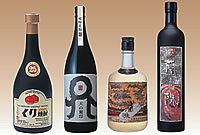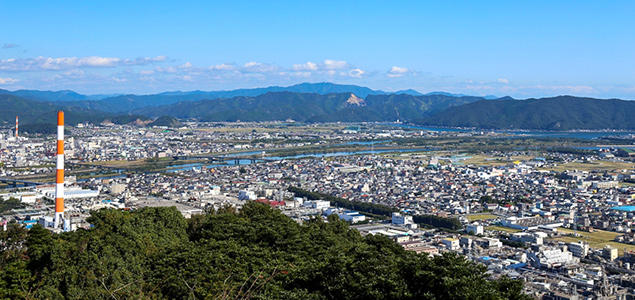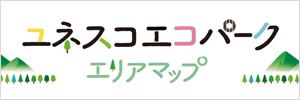本文
Gourmet Town Nobeoka
Nobeoka is well known for regional food products and delicious dishes, including Chicken Nanban, a fried chicken cutlet dipped in a sweet vinaigrette, which was invented in Nobeoka and became a popular dish nationwide. To increase awareness of the commercial potential of Nobeoka's regional food products, and as a delicious way to revitalize the regional economy, the "Eastern Kyushu Basque Regional Plan" was launched. Many events, including visits by Massimo Bottura (Osteria Francescana) and Jiro Ono (Sukiyabashi Jiro), as well as various "Nobeoka Tapas" events have been held as part of this plan.
Nobeoka is also known as a "City of Rivers" where clear water flows. The three breweries located in Nobeoka use clear river water to produce delicious craft beer, sake, and shochu.
Special Dishes and Products from Nobeoka
Chicken Nanban
Nobeoka is the birthplace of Chicken Nanban. There are multiple versions of Chicken Nanban in Nobeoka, and the most popular version includes tartar sauce. Considered the soul food of Nobeoka, Chicken Nanban is not only offered in restaurants and bars, but various other kinds of establishments, such cafes and sushi restaurants, which have also developed their own original recipes.

"Sky Flying" Young Spring Onions (Sora Tobu Shin-Tamanegi)
"Sky Flying" Young Spring Onions is a brand of onion created to be the earliest onions to come on the market during the season in Japan. Their sweetness and crisp texture is perfect for salads. They are also used in processed foods such as konnyaku (a gelatinous food made from devil's-tongue starch), soup, and dressings.

Torn Sweet Bean Steamed Buns (Yabure Manjyu)
It is said that Torn Sweet Bean Steamed Buns were made in the area near Nobeoka Castle from as early as 1614.
Their original name was "Agatama Manjyu," but they gradually came to be called "Yabure Manjyu," due to the torn pieces of their outer surface which allowed the sweet red bean inside to be seen. "Yabure" means "torn" and "manjyu" is a "steamed bun with sweet bean inside."

Delicacies from the Sea and Rivers
Gokase River Ayu (Sweetfish)
From October to the beginning of December, "Ayu fish traps" are built across the clear waters of the Gokase River. These wooden traps are a traditional method of fishing that has continued for over 300 years. You can enjoy the taste of autumn at Ayu restaurants set up along the river, with dishes such as steamed rice with Ayu, miso roasted Ayu, and salted roasted Ayu with roe. The local specialty, Ayu with roe on rice, is an extravagant dish. It features one fish with roe stewed in soy sauce and sugar, then placed on a bed of Ayu meshi (rice that has been steamed with Ayu) which is seasoned with finely chopped ginger.

Spiny Lobster (Ise Ebi)
Between the period of September and March, the spiny lobster fishing season opens in the Hyuga-nada Sea, and many spiny lobsters are caught. Freshly caught spiny lobster smells of the sea and has a rich flavor. We recommend such simple dishes as raw lobster, salted roasted lobster, and miso soup with lobster. The Lobster Festival is held from September to November on the "Eastern Kyushu Lobster Coastal Road," which connects Nobeoka to Saiki in Oita Prefecture. You can taste locally caught lobster cuisine at eateries along the coastal road.

Round Green-eyes Fish (Mehikari)
Mehikari lives in the depths of the Hyuga-nada Sea. This fish is named for its unique shining green eyes. The pale white flesh of the fish is most often enjoyed in deep-fried dishes, in which the bones of the fish can also be eaten.

Dried Fish
Fresh fish caught in the Hyuga-nada Sea and then dried, are packed full of essential fatty acids and have a rich flavor. Dried fish are a very popular item at the Kitaura Roadside Stop.
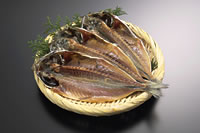
Miyazaki Fish Brand
The fishing industry prospers in Kitaura, which faces the Hyuga-nada Sea. Among marine products caught in the area, "Kitaura Seahorse Mackerel," "Himuka Honsaba," and "Miyazaki Amberjack" have been recognized under the "Miyazaki Fish Brand" and are highly regarded nationally.
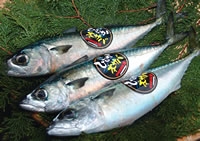
Mountain Delicacies
Wild Boar Hotpot (Botan Nabe)
Wild Boar Hotpot, is filled with plenty of vegetables and the meat of local wild boar is a representative hotpot dish of Kitagawa. Wild Boar Hotpot features thinly sliced pieces of wild boar meat, shaped like the flower of a peony for decoration, placed on the serving plate alongside the vegetables and other ingredients to be cooked in the hotpot. The dish is referred to as Peony Hotpot in English because "botan" translates to peony.

Jiro Persimmon (Jirogaki)
The Jiro Persimmon, a variety of Japanese persimmon, is a noted product of Kitakata. They are harvested from the end of October through November. Brandied Jiro Persimmons are a popular gift item and have a delightful aroma.

Chiyohime Peaches
The Chiyohime Peach is a small, sweet, early-ripening peach harvested around June. Chiyohime Peach flavored sherbert, ice cream, and jellies are popular products.

Bamboo Shoot Sushi (Takenoko-zushi)
Bamboo shoot sushi uses the shoot of black bamboo, which is harvested from May through June. It was awarded the National Agricultural Cooperative Center President's Award at a national hometown rice ball contest.

Japanese Yams
Japanese yams are harvested from the beginning of November through December. They have a unique flavor and consistency, are used in a variety of dishes, and have gained attention as a health food.

Local Alcoholic Beverages
Sentoku Sake
Sentoku Sake (rice wine) is made from rice and water utilizing microbes such as yeast and koji-mold. Sentokushuzo is the only specialized sake brewery in Miyazaki Prefecture and has over 100 years of history. Making sake requires high level fermentation techniques. Sentokushuzo continues to brew delicious sake that is loved by both foreigners and locals alike.

Hideji Beer
The Hideji Beer brews beers ranging from traditional styles enjoyed around the world to truly original Hideji brews, all created with ingredients grown locally. This makes Hideji a true Japanese craft beer. Hideji Beer has won many national and international prizes for their great products.

Sato Shochu
Miyazaki Prefecture is also well-known for producing Shochu, a popular Japanese liquor. There are various ways to enjoy shochu. Sato Shochu is a distillery located on the banks of the Houri River. The distillery uses traditional techniques to produce shochu with natural ingredients, such as rice, barley, sweet potatoes, and chestnuts.
